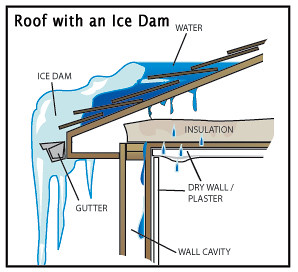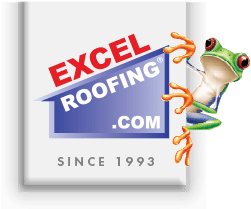The roofing system consists of four vital components:
- The Roof cover material
- Attic ventilation
- Attic Insulation
- Rain gutters & Proper roof drainage
All of these components need to be chosen for the best look for the home and also value for the customer. Then the components need to be correctly installed to obtain maximum performance for the homeowner.
Asphalt Roofs
The first part of the system is the Roofing material. The type of material, color, and how the Roof is applied will impact may things such as;
- What will the roof look like?
- How easily is the roof damage by hail?
- How much heat will the roof absorb and transfers into the home.
- How fast snow slide off the roof
- How much will it cost to insure the roof
When deciding on a new roof for a home, all of these factors should be considered when making the decision about the roof material. Keep in mind all roofs all have pros and cons.
The most common roofing material in America is Asphalt Shingles. Asphalt Shingles have dramatically transformed since the early 1990’s. They have changed from a low-end roof covering to multiple designs, thicknesses, and price points from low to high. Asphalt shingles are generally guaranteed from 25 years to the lifetime a Homeowner owns the home. Asphalt shingles do absorb and transfer a considerable amount of heat into the home. Inexpensive Asphalt Shingles are easily damaged by hail. The more expensive Asphalt shingles are made with a rubber like core and the hails tends to bounce off these shingles. Most insurance companies will give the Homeowner a discount for having a Class 4 Impact resistant roof.
Pros: The most options of any roof covering * The least expensive $ roofing
Available * Many types of Class 4, Impact Resistant Asphalt Shingles available
Cons: Cheap shingles are easily damaged by hail * Asphalt shingles have a short life
Expectancy * Some Asphalt shingles can be expensive $$
When deciding on a new roof for a home, all of these factors should be considered when making the decision about the roof material. Keep in mind all roofs all have pros and cons.
Concrete Tile Roofs
Concrete Tile roofs are supposed to last 50 years. It is important to understand that a high-quality underlayment system is critical to getting 50 years of service from a tile roof. Excel has replaced many tile roofs that were not installed to the quality standards, and this has caused problems for the homeowners well before 50 years. Excel installs Tile roofs designed to last the 50 years. The Tile is installed on an elevated batten system, so the tile are not in direct contact with the roof deck, the heat absorbed by the tiles does not pass directly to the roof deck and into the home. Tile roofs are long-lasting and great choice especially when replacing a Cedar Shake Roof.
Pros: High end roof covering that adds value to home
Long lasting * Hail resistant * low maintenance Roof * Easy to Repair
Cons: Heavy Weight, A structural engineer needs to evaluate the home and sometimes additional bracing is necessary to reinforce the home’s framing
Moderately expensive $$$ * Tiles can be broken by foot traffic
Metal Roofs
Residential metal roofing is divided into 2 types of styles. The First is vertical panels that are screwed on through the top or have the fasteners hidden. The second type is horizontal panels that try to mimic Shake or Tile roofs. These panels are referred to as stone coated steel. Metal roofing is lightweight and can have a thick look. Stone Coated Steel panels have granules glued on top for color. These are the same granules used on Asphalt shingles. Stone Coated Steel panels can be dented when walked on. The granules can be knocked off by hail, which may not be covered by insurance. Most Steel roofs are Class 4 Impact resistant, and qualify for insurance discounts.
Pros: Lightweight * Long Life Span * Stone coated steel roofs look thick and have a high end curb appeal * Vertical panels are moderately priced $$
Cons: Snow sliding off the vertical panels and can be dangerous * Exposed panel screws need to be re-tightened about every 5 years * Stone coated Steel panels can be dented by foot traffic * Stone coated steel roofs are expensive $$$$
Synthetic Roofs
There are two main manufacturers of synthetic residential roofing material, Da Vinci and F-Wave. Da Vinci Roofing products have been around for over 20 years. They are durable and have a thick Cedar Shake or Slate-like appearance. F-Wave roofing material is relatively new. Their patented manufacturing process produces granule free, plastic synthetic shingles that are durable, resistant to cracking and fading and have an asphalt shingle appearance. The cost of this shingle is about double the price of asphalt shingles.
Pros: Extremely Hail resistant, the most hail resistant product on the market today *Qualifies for Class 4 insurance discounts * Wide variety of profiles, can look like Asphalt shingle, Cedar Shakes, or Slate
Cons: Expensive $$$$
Cedar Shake & Shingle Roofs
Shake roofs are like Bell bottom pants. In the 1970’s it was the thing to have. Now a shake roof will get you an insurance surcharge, and when the home is sold most buyers will demand a new roof. Despite the fact that insurance companies don’t like Cedar Shake roofs they do have some good attributes. Cedar Shake roofs are the greenest roof possible; they are naturally grown. The Cedar wood absorbs minimal heat, and because they are a natural insulator, they transfer very little heat into the home. Shakes are made of Cedar Wood which is naturally bug resistant, and resists rot. These days Excel usually only installs Cedar Shake roof on historical structures where it is required to match original roof materials.
Pros: Green Roof * Natural insulator does not Transfer Heat * Bug and Rot Resistant
Cons: Many Insurance Companies will not insure this type of roof * Easily damaged by hail * Expensive $$$
Attic Ventilation
Attic ventilation is the second component of the roofing system. It is the most important factor in keeping the attic cool. The best attic ventilation is when air flow is balanced, 50% entering the lower area, 50% exiting the top. The heat in an under-ventilated attic can actually damage the asphalt shingles on your roof, causing them to “cook” and blister in the intense heat. This can void manufacturers’ warranties.
The coolness of the attic will affect the overall temperature of the house and can greatly affect the efficiency of the cooling system. In the summer when the temperature is 95 degrees an attic can reach 160 degrees if it’s not properly ventilated. This is going to cause the house to be hot, and stay hot. It also causes the air conditioner to work overtime. Proper attic ventilation is a key component of the roof system.
Attic Insulation
Attic insulation is the third component in the roofing system. Most homes built in the 70s and before had about 3.5 inches of attic insulation. This was because of lax building codes and the fact that energy was cheaper than insulation. Insulation is measured in R-value, e.g. the resistance to heat flow through a given thickness of material. The higher the R-value, the greater the resistance. Today’s Standard for our area is R-49, or about 20 inches of insulation.

An under insulated attic floor can cause up to 40% of the homes heated air to be lost through the ceiling. In the winter this escaping heat from your home will rise and gather in the top of the attic. This heat will then permeate through the roof in the absence of proper ventilation. If the home is in a snow region this will cause the snow to prematurely melt which in turn causes ice dams at the eaves. An overly heated attic can also cause water vapor to condense. If this moisture cannot escape (proper ventilation) there is a chance of water accumulation in the attic of the home. In these cases homeowners think they have a roof leak, only to find out that there is excessive moisture in the attic leaking down through the ceiling.
Insulation will keep the warm air in your home and should reduce heating costs.
Rain Gutters & Proper roof drainage
Rain Gutters & proper roof drainage are the fourth component of the roofing system. In areas with expansive soil such as Colorado & Wyoming proper water drainage away from the home is critical. If the water is allowed to accumulate next to the base of the home damage to the foundation can occur. The best practice is to direct all water at least 4 feet away from the home. Clogged gutters are one of the most common gutter problems Excel sees. Clogged gutters causes water to overflow the gutters next to the home, this can flood a basement, which is not covered by insurance. Excel has not seen a gutter protection system that work effectively.
Because of this Excel recommends cleaning the gutter at least once a year, late October after the leaves fall is the best time to do this. If the home is has lots of trees around it cleaning the gutters in both Fall & Spring is a good idea.
Conclusion
Each component of the roofing system is important. They must designed, and installed correctly for the system to function as a whole. At Excel, we specialize in entire roofing systems from choosing the right roofing material, making sure the attic ventilation is correct, we can help evaluate the insulation, and make sure the gutter system works properly. We make sure every element of your roofing system is installed correctly and works effectively. Whatever your roofing needs are Excel Roofing can help you. Whether you need a leak repaired or a complete roof replacement contact Excel Roofing today!





